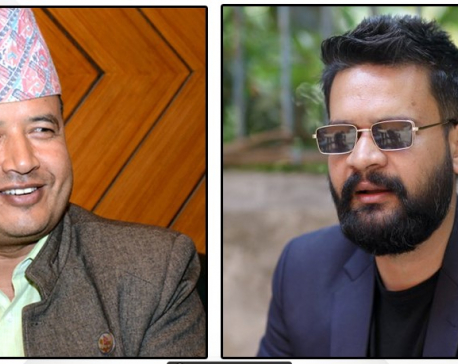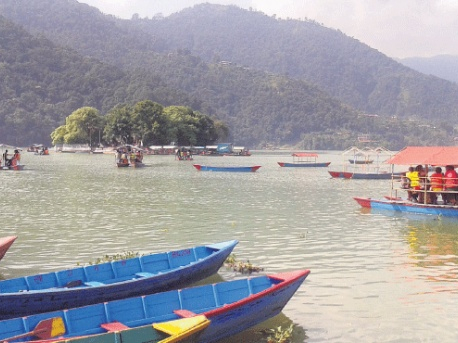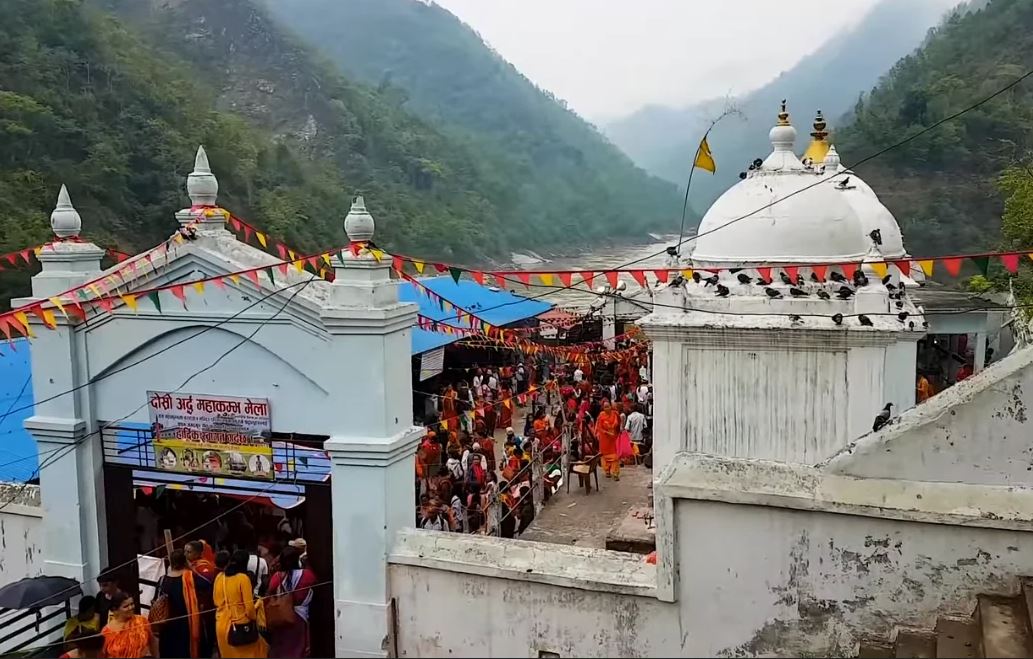
OR
High-altitude yak festival draws tourists from India, China and Bhutan
Published On: April 16, 2019 04:30 AM NPT By: Giriraj Baskota

PANCHTHAR, April 16: It is situated at an altitude of 3,340 meters from the sea level. Herds of yak were moving in a relaxed manner. They would become invisible the very next moment, thanks to the fogs suddenly that turns thick any minute. Hundreds of tourists thrilled with the fog and the scenery were also capturing rhododendrons blooming around. Tourists, most of them from India, exclaimed that such a magificent view is only found here, in Nepal.
It was a glimpse of one-day yak festival organized at Charrate of Falelung Rural Municipality on Saturday. The third yak festival had drawn a considerable number of Indian tourists as the venue lies near the Nepal-Indo border.
Organized by the Rural Municipality itself in association with Nepal Tourism Board and several other local bodies’ the festival aims to promote eco-tourism, conserve wildlife and nature and boost cross tourism.
According to Indra Bahadur Angbo, Finance and Planning Minister of Province – 1, the event has encouraged even Bhutan and China to organize similar festivals in their countries. “When it was organized in Nepal for the first time, they were very curious to know the outcome. It cannot be organized everywhere since yak are not available every time. Here, it became so exciting at the very first time that other countries were highly impressed,” he noted. He added that the
provincial government highly regards the significance of the festival and is committed to making it even grand in the days to come.
“Our place is wonderful, within a very small area of land we have diverse varieties of climate. We have an equally diverse species of animals and flora and fauna. Yak are one of these,” he remarked. “Our farmers who were otherwise rather quitting goat farming are now gradually getting encouraged.
We want to promote tourism, agriculture, culture, wildlife through such events,” he added. Angbo further informed that the provincial government had allocated Rs 1.5 million for the conservation of yak. In the coming years, the budget for the program will be increased based on the needs assessment.
For the festival, yak were brought from several areas of Taplejung and Panchthar. Stalls of milk products of yak attracted huge crowds. Domestic tourists from Jhapa, Panchthar, Taplejung and Ilam had added to the thrill. Participants from China and Bhutan looked no less excited.
Unlike other seasons, hotels near Sandakpur and Aahal were all full of visitors. Temporary or mobile eateries were equally crowded. “Look at the location, the topography here. It’s challenging to reach this point due to the lack of roads. Yet, so many guests, visitors, tourists have come here. This is amazing,” Angbo noted.
Shepherds and owners of the yak had reached the venue one or two days before the event.
Another attraction of the festival for the tourists were yak rides along with horse races. Adding to the excitement were the deliciously cooked authentic local cuisines, folk music and dances of Nepal and India.
The visitors to the event belonged to all group of ages and all walks of life. Many had let the world know of the excitement by streaming the events on their social media channels.
Former lawmaker Bishmaraj Angdembe, however, lamented the lack of promotion of the event before the date. Had the organizers well promoted the event, the number of visitors would have been much more, he said.
“This is an amazing festival. It is a lifetime experience. People would have come here from several countries had they been informed on time. From next time, the government, the organizers should make much better preparation to advertise the festival,” he said. He added that the festival has however established itself as a brand and will greater fame in the days to come.
Professional goat farming is conventional in Falelung, Yangwarak, Sidingwa, Shreejangha, Faktanglung and Mikwakhola, among other villages of Taplejung and Panchthar. But compared to the past, fewer households are into this profession nowadays. According to locals, new generations are not much interested in the ‘tough job’. Organizers claim that the festival as well as other incentives and packages offered by the government for agriculture will not only revive ‘yak culture’ in the region but will make it even more popular in the high hills.
You May Like This

UML leader Basnet to Balen: Don't be pampered just because you have a few hundred fans on Facebook
KATHMANDU, August 26: While the Mayor of Kathmandu Metropolitan City (KMC), Balendra Shah, is speeding up the work to demolish... Read More...

Chinese film festival set to kick off in Kathmandu
The annual Chinese film festival is going to be held at National Cultural Cooperation from September 17. ... Read More...

Pokhara eyes more Indian visitors
POKHARA, July 4: Tourism entrepreneurs of Pokhara have set a target of increasing the share of Indian arrivals in total tourist... Read More...





Just In
- NEPSE lost 53.16 points, while investors lost Rs 85 billion from shares trading last week
- Rainbow tourism int'l conference kicks off
- Over 200,000 devotees throng Maha Kumbha Mela at Barahakshetra
- Indians vote in the first phase of the world’s largest election as Modi seeks a third term
- Kushal Dixit selected for London Marathon
- Nepal faces Hong Kong today for ACC Emerging Teams Asia Cup
- 286 new industries registered in Nepal in first nine months of current FY, attracting Rs 165 billion investment
- UML's National Convention Representatives Council meeting today






_20220508065243.jpg)






Leave A Comment